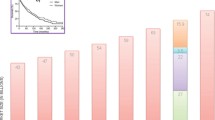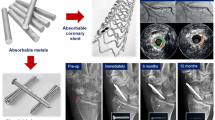Abstract
This study describes the structure and performance of an encapsulated, implantable aluminium/platinum black electrochemical cell. It is covered with a silicone rubber membrane, and the anode and cathode compartments are separated by an anionic ion exchange membrane.In vitro studies and intermittentin vivo tests with rats demonstrate that a cell of 5·5 cm2 area gave a continuous power output of more than 70–100 μW at 0·9 V over 12 months. Although the results of long term implantation experiments now in progress remain to be assessed, preliminary data show that there was no leakage of waste products, and that tissue-cell reactions should not be serious enough to affect cell performance. It is considered that this cell can overcome the disadvantages of unencapsulated biogalvanic cells, and that it offers great promise as a long-termin vivo power source.
Sommaire
Cette étude décrit la structure et le comportement d'une cellule électrochimique aluminium/platine capsulée et implantable. Elle est recouverte d'une membrane en caoutchouc silicone et ses compartiments d'anode et de cathode sont séparés par une membrane anionique échangeuse d'ions. Des étudesin vitro et des testsin vivo effectués sur des rats démontrent qu'une cellule de 5,5 cm2 donne une sortie de courant de plus de 70–100 μW à 0,9 V pendant plus de 12 mois. Bien que les résultats d'expériences d'implantation à long terme effectués actuellement demeurent sujet à confirmation, les données préliminaires démontrent qu'il n'existe pas de pertes de produits et que les réactions des cellules de tissus ne sont pas suffisamment importantes pour affecter le comportement de la cellule. On considère que cette cellule peut surmonter les désavantages des cellules biogalvaniques capsulées et qu'elle offre de grands espoirs en tant que source d'énergie à long termein vivo.
Zusammenfassung
Diese Untersuchung beschreibt den Aufbau und die Leistung einer verkapselten, verpflanzbaren, elektrochemischen Aluminium/Platinmohrzelle. Sie ist mit einer Silizium-Gummimembran überzogen, und die Anoden- und Kathodenabteilungen sind durch eine anionische Ionenaustauschmembrane getrennt.In vitro Untersuchungen und intermittierendin vivo Teste mit Ratten zeigen, dass eine Zelle von 5,5 cm2 Fläche eine ständige Leistungsabgabe von mehr als 70–100 μW bei 0,9 V über einen Zeitraum von 12 Monaten lieferte. Obwohl die Ergebnisse von lang andauernden Verpflanzungsexperimenten, die jetzt stattfinden, erst beurteilt werden müssen, so zeigen vorläufige Daten an, dass kein Leck von Abfallprodukten erfolgt, und dass Gewebe-Zellenreaktionen nicht so ernst sind, um die Zellenleistung zu beeinflussen. Es wird angenommen, dass diese Zelle die Nachteile unverkapselter, biogalvanischer Zellen überwinden kann, und dass sie grosse Aussichten für eine langanhaltendein vivo Kraftquelle bringt.
Similar content being viewed by others
References
Anagnostopoulos, C. E. andKennedy, J. (1964) Electronic pacemakers of the heart, gastrointestinal tract, phrenic nerve, bladder, and carotid sinus: Current status.Surg. 60, 480–494.
Bradley, S. (1969) In:Biomaterials, pp. 67–89 (Eds.L. Stark andG. Agerwal) Plenum Press, New York.
Burns, N. (1969) Production of a silicone rubber film for the membrane lung.Bio-Med. Engng 4, 356–359.
Enger, C. andKennedy, J. (1964) An improved bioelectric generator.Trans. Am. Soc. Artif. Intern. Organ. 10, 373–377.
Griffin, L. S. C. andSchwartz, S. I. (1964) Reversal of renal hypertension by electrical stimulation of the carotid sinus nerve.Surg. 56, 232–239.
Kortus, T. (1967). The carbohydrate metabolism accompanying intoxication by aluminium salts in the rats.Experientia 23, 912–913.
Massie, H., Racie, P., Parker, R., Hanh, A. W. andSun, H. H. (1968). Study of power generating implantable electrodes.Med. biol. Engng 6, 503–516.
Myers, G. H. andParsonnett, V. (1969)Engineering in the Heart and Blood Vessels. Wiley-Interscience, New York.
Parsonnett, V., Lewin, G., Zucker, I. R. andAvery, R. (1968) A nonpolarizing electrode for endocardial stimulation of the heart.J. Thorac. Cardiovasa. Surg. 56. 710–716.
Roy, O. Z., Wahnert, R. W., Heggveit, H. A. andWaddell, W. G. (1970) Bioelectrical energy sources.Ann. N.Y. Acad. Sci. 167, 645–660.
Sandall, E. B. (1959)Colorimetric Determination of Traces of Metals, 3rd Edn. Interscience, New York.
Schaldach, M. (1969) Bioelectric energy sources for cardiac pacing.Ann. N.Y. Acad. Sci. 167, 1016–1023.
Shelly, T. (1969) Electrical control of urinary inconvenience—physiology.Bio-Med. Engng 4, 504–506.
Strohl, T. L., Scott, R. O., Freezel, W. J. andWolfson, S. K. Jr. (1966) Studies of bioelectric power sources for cardiac pacemakers.Trans. Am. Soc. Artif. Intern. Organs. 12, 318–326.
Thalen, H. J. T. H., Van der Berg, J. W., Van der Heide, J. N. H. andNieveen, J. (1969)The Artificial Pacemaker, its History, Dvelopment and Clinical Application. Royal Van Gorcum Publishers, Assen, Netherlands.
Tantrum, A. D. S. andTseung, A. C. C. (1969) Structure and performance of hydrophobic electrodes.Nature, Lond. 221, 5176, 167–168.
Tseung, A. C. C., Wan, B. Y. C. andKing, W. J. (1969) U.K. Patent application 51401/69.
Wolfson, S. K. Jr., Gofberg, S. L., Prusiner, P. andNanis, L. (1968) The bioautofuel cell: a device for pacemaker power from direct energy conversion consuming autogenous fuel.Trans. Am. Soc. Artif. Intern. Organs. 14, 198–209.
Author information
Authors and Affiliations
Rights and permissions
About this article
Cite this article
Tseung, A.C.C., King, W.J. & Wan, B.Y.C. An encapsulated, implantable metal-oxygen cell as a long-term power source for medical and biological applications. Med. & biol. Engng. 9, 175–184 (1971). https://doi.org/10.1007/BF02474813
Received:
Issue Date:
DOI: https://doi.org/10.1007/BF02474813




